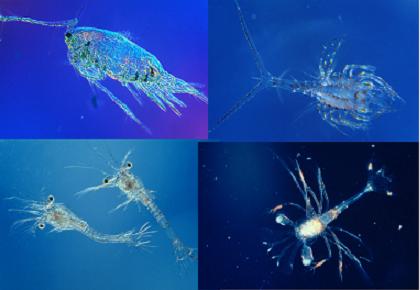Measurement of the unique glow emitted by the tiny phycoplankton allows predicting the health of the oceans and measuring the impact of human activity on the health of the marine environment

A red glow of plants in the oceans was detected by NASA satellites. Not long ago, according to the monthly Biogeosciences. It turns out that measuring the unique glow allows predicting the health of the oceans and measuring the impact of human activity on the health of the marine environment.
The red glow is emitted by tiny plants - phytoplankton, the same phytoplankton that turns sunlight into energy through assimilation (photosynthesis), a process that is the basis for creating most of the food in the marine environment, the phytoplankton that, according to estimates, produces more than half of the assimilation activity on our planet. The phytoplankton is eaten by the zooplankton, fish, molluscs and thus forms the basis of the food chain in the oceans.
Therefore: the health of the phytolankton plants affects the health of the entire marine environment, the health of which depends: commercial fishing, the amount of carbon dioxide. that the oceans absorb, the response of the oceans to global warming and more.
In the last two decades, the amount of chlorophyll in the marine environment has been measured, measurements that gave an index of the amount of plants in the oceans, and now with the help of the Moderate Resolution Imaging Spectroradiometer (MODIS) located on the Aqua satellite, NASA scientists have succeeded" A. to detect the red-light fluorescence and with its help to assess the level of activity of the phytoplankton in the vastness of the ocean,
Scott Doney, marine chemist from the Woods Hole Oceanographic Institution Woods Hole Oceanographic Institution explains that if the chlorophyll gives a picture of the amount of phytoplankton, then the red glow gives a picture of the normal activity / health of the phytoplankton and the health of the environment,
All plants absorb energy from the sun, usually more than can be utilized by assimilation. Most of the remaining energy is released as heat, but a tiny amount is released as red fluorescent light. This red light makes it possible to understand the physiology of marine plants and the efficiency with which assimilation takes place.
The different parts of the plant that harvest the energy are activated according to the amount of light and food available, an activity that is expressed in the amount of red glow, for example when the phytoplankton is distressed due to a lack of iron, the level of red glow increases.
This is how MODIS gives researchers a tool that allows them to know where the water is rich in iron and where there is a lack, which makes it possible to understand how changes in the concentration of iron affect the plankton.
Iron is an important component of nutrients and is therefore used as an indicator. Iron reaches the oceans naturally (mainly) through river estuaries and by storms that transport dust from deserts and dry areas. Moody's showed that parts of the Indian Ocean "illuminate" less with a red glow during the monsoon season (winds from the southwest) as well as the "trade" winds that stir the water and bring sediment to the surface.
It is possible to measure the effect of the winds that carry dust or river discharges over different periods of time - weeks, months and even years. And it turns out that the measurement data is affected by global warming. as well as from other (worrisome) human activities.
Climate change causes stronger winds that transport more dust to the seas, or alternately weak winds that leave water free of dust. Areas will dry out and others will be wetter which will cause dust to reach the sea from other areas. All these changes can be seen by measuring the red glow produced by the phytoplankton.
Asaf

5 תגובות
I've always been into anything red
Someone else entirely:
Too bad.
If you weren't so petty you would learn something interesting.
A little too many spelling mistakes for one article: "Phycoplankton" in the title followed by "Zooplankton"
And "Phytopancton" and then I decided to stop reading…..
An illuminating article..
Lllllllllllllllllllllllllllllllllll